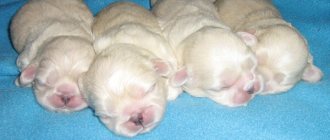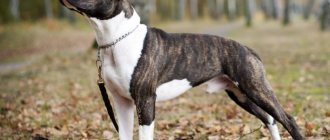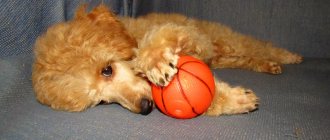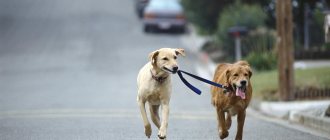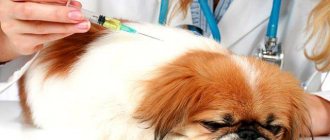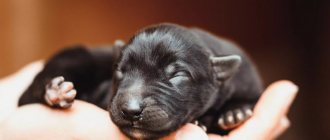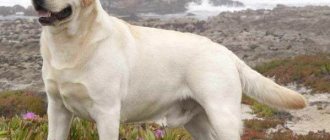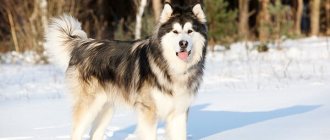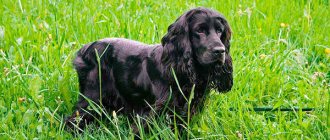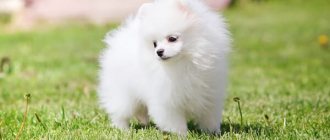From childhood, Pekingese puppies are calm, phlegmatic and stubborn.
These small dogs are often capricious and disobedient, but at the same time they are well aware of the owner’s mood and know how to adapt to it.
Since childhood, such a dog is quite self-sufficient; he will never impose himself or fulfill demands that he does not like.
Pekingese puppies are difficult to train and can only master the simplest commands.
Photos of newborn puppies
The neonatal period for Pekingese puppies lasts approximately 12 days.
Immediately after birth, babies are completely helpless and are unable to see, hear, or empty their bowels and bladder. A newborn is only able to respond to smell, temperature and touch. In addition, it does not have thermoregulation and is heated by the mother. Babies' eyes open 12-15 days after birth.
The weight of a newborn is 150-250 g, height 15-20 cm. However, the size of the babies may vary depending on how many puppies the bitch gives birth to.
Breeding
Breeding must be approached very responsibly. First of all, make sure that your dog does not have any pathologies. It is not advisable to breed animals from the same litter. It is also important to inquire about all the documents of your partner dog.
Estrus
If you are planning to breed your dog, keep a notebook and mark the beginning and end of the estrus there so you don’t miss the right day for breeding. Walking with a female dog during heat requires only a leash.
It is not advisable to breed animals from the same litter
Mating
The bitch is always taken to the dog's house, and not vice versa. In unfamiliar conditions, he may become confused and then fertilization will not be successful. It is not recommended to bathe animals before mating, so as not to wash away their natural odors. The bitch needs to be given a good walk on the day of mating. Due to the peculiarities of their physiology, Pekingese dogs get tired quickly, so it is necessary to constantly monitor the male’s well-being and take breaks after unsuccessful mountings.
Childbirth
If a dog gives birth for the first time, it is advisable to have a veterinarian attend the birth. A few hours before birth, mucus is released from the loop. Don't leave your pet alone from now on. After birth, you should not bring the cubs to the mother’s face - her reaction can be unpredictable.
If a dog gives birth for the first time, it is advisable to have a veterinarian attend the birth.
Development from 1 to 12 months
| Pet age | Size | Weight | Description |
| 1 month | 15-20 cm in length | At the end of the period - weight 500-700 g. | In the first month of life, the puppy feeds on its mother's milk. Starting from 3 weeks of age, the dog already shows interest in solid food. A Starting from 14 days, his eyes and ears come off, and his intestines begin to work independently. |
| 2 months | 25-35 cm in length | 800-1100g | The baby masters the principles of social behavior, he has already developed all physiological functions, and he also completely switches to solid food. In the middle of the 2nd month, the puppy is gradually weaned from its mother. |
| 3-4 months | 8-10 cm at the withers | 1.2-2 kg | The baby's teeth begin to change, and signs of character also appear. At this age, the pet awakens to its individuality. |
| 4-6 months | 10-12 cm at the withers | 2-5 kg | The dog gains significant height and weight, and also begins to show interest in the opposite sex. |
| 7-9 months | 12-15 cm at the withers | 3-6 kg | Now this is a teenage dog, the pet’s character and habits have already been practically formed, and active hormonal changes associated with puberty begin in the body. |
| 10-12 months | 15-25 cm at the withers | 5-7 kg | At this age, females begin their first heats, and males become more active, marking their territory and trying to take a higher place in the hierarchy. |
Safety precautions
If a shepherd puppy grows up in a city apartment, a number of rules must be followed to protect it from injury. There are almost no differences here from other puppies or even small children:
- Wires should be hidden in special boxes or plinths.
- Strengthen or remove unstable furniture.
- Don't let him play with small, fragile toys: he will definitely break them and swallow the fragments.
- Anything that lies within his reach will be stolen and turned into a toy, so things must be put away in cabinets and drawers.
- To prevent the puppy from sharpening its teeth on all surrounding objects, it must have its own training equipment. They are sold in abundance in veterinary pharmacies - these are bones from ox veins, and scraps of rope, and cast heavy balls. You need to bring home 2-3 toys, and he will choose his favorite one.
- There should be a carpet or other similar covering on a slippery floor: the puppy’s weak paws are easily injured on a slippery floor.
- If there are children in the house, they need to be instructed how to properly handle the dog. The main thing is not to allow him to be picked up: even at three months he is quite heavy, up to 10 kg, and his paws are weak, they can easily be injured if he is accidentally dropped.
Basic care rules
Rules for caring for a Pekingese puppy include:
- Brushing with the help of special brushes and combs; you need to comb your baby daily to avoid the appearance of tangles.
- Daily walks for 30-40 minutes 3 times a day.
- The puppy is bathed as needed using a special shampoo and conditioner for coarse coats.
- You can cut your pet's hair starting from 6 months of age. Approximately once every 2 months, cosmetic haircuts should be performed, paying special attention to the paw pads and the space between the toes.
- Eye care must be performed with special care due to their structure. The Pekingese's eyes have a shortened tear duct, so they are susceptible to inflammation and injury, which means that they need to be wiped daily with a cotton pad and a special solution. Also, the puppy's eyes should be examined daily for inflammation of the tear ducts.
- Nails are trimmed once every 2 weeks using a special nail clipper.
- Regular examination by a veterinarian (at least every six months) is an integral part of good care.
- Timely vaccination according to schedule.
- Carrying out deworming and antiparasitic treatment.
Home maintenance
Keeping a Pekingese at home is not difficult, which is why they are so popular. It is easy to create a comfortable environment for such a dog; it does not require anything special. The only thing the owner will need to provide is two half-hour walks every day. Pekingese are very active - movement is literally vital for them.
Training
Significant difficulties may arise with training due to the animal’s excessive stubbornness. Many representatives of this breed cannot be trained to use a leash. Education and training in this case will require a lot of patience from the owners. One of the positive aspects is that training does not require any special platforms or devices. It is quite possible at home.
Keeping a Pekingese at home is not difficult, which is why they are so popular
You need to start learning from an early age. It is very important to repeat the skills daily until they are fully mastered. This will help secure them securely, bringing them to automaticity. If the puppy shows excessive stubbornness and does not respond to the owner’s commands, it is recommended to send it to a dog handler for training.
Care and hygiene
Although Pekingese are quite unpretentious, unprepared owners may have some difficulties.
These dogs very quickly get used to the rules established by the owner, trying to follow the usual routine. Many will see the advantage in the fact that it is quite possible to train such a dog to a litter tray. This is undoubtedly useful, but does not mean that it will save the owner from daily long walks with the pet.
After walking outside in the warm season, you need to carefully check your pet for ticks. And also constantly monitor for the presence of fleas, which the puppy can pick up after contact with other animals. If fleas do appear, veterinarians recommend the drug Frontline, which is sold in the form of a spray or drops.
Hygiene recommendations:
They very quickly get used to the rules established by the owner, trying to follow the usual routine.
- The pet is taught hygiene from puppyhood. During events, it is important to constantly maintain contact with the animal, talk to it, and encourage it.
- First, decide on the place that you will allocate for the toilet for the animal. Tray training may take several months. Be patient and remember that rudeness will not help in learning, but, on the contrary, will worsen the result.
- All hygiene procedures must be carried out at the same time, otherwise the dog will perceive it as something bad and will begin to avoid them.
- In addition to the toilet, the pet should have a personal space - a secluded corner where he can rest. It is better to place a special bed there for sleeping.
- The animal is not bathed often. If necessary, you can use dry shampoos. All hygiene products must be purchased from pet stores or veterinary pharmacies; use of drugs for humans is not allowed.
Behind the ears
Your pet's ears should be examined every day. It is advisable to regularly wipe them with a cotton swab, like the fold of the nose, to avoid the accumulation of secretions and sweat. If there is an unpleasant odor coming from your pet's ears, you should contact your veterinarian immediately.
Behind the wool
Gorgeous coat is the main advantage of this breed. Accustoming your pet to hygiene begins with brushing. The puppy is brushed daily, calming and encouraging. Many owners groom their Pekingese not only to achieve the desired appearance, but for hygienic reasons.
Behind the teeth
To ensure that the replacement of baby teeth goes smoothly, it is recommended to regularly consult a veterinarian. It would also be a good idea to purchase a special bone that your baby can chew on.
Gorgeous coat is the main advantage of this breed.
Behind the claws
Pekingese claws are very sharp, the puppy can be injured. In addition, they grow quite quickly - if you miss the time and do not trim them on time, they will grow into the pads of the paws. The dog will experience torment, and to correct the situation, you will have to resort to surgery. Nails must be trimmed at least once a month with nail clippers. If necessary, the procedure is carried out more often, but only with the approval of the veterinarian.
How to toilet train?
Given the innate stubbornness of the Pekingese, babies should be toilet trained exclusively through interest and encouragement. In the beginning, you should use a diaper or tray with filler.
From the first days of your dog's stay in the house, you should show him the place where he needs to defecate. At the initial stage, you can use several diapers or trays and place them in those places where the puppy most often does his business. He should have a clear association with the litter box and emptying. After a while he himself will look for it.
The second stage is toilet training outside. You can do this from the very first walks. To do this, you need to walk with the baby until he goes to the toilet, and then praise him and treat him with a treat. The goal is to reinforce in the dog’s mind that defecating on the street is associated with positive emotions.
NOTE!
When training a Pekingese, you should not use a punishment system; these dogs simply will not understand this approach and the result will be the opposite.
History of the origin of the breed
The origin of the Pekingese is evidenced by the name of the breed - in English it means “Peking”, from where these dogs were brought to England. It is believed that the breed first appeared close to 2000 years ago. However, it became widespread only towards the end of the 19th century, when it was taken out after the capture of the Summer Palace in 1860. Until this time, only the Emperor of China and members of his family had the right to own Pekingese.
Pekingese has always been a popular breed of dog, such a puppy is the cherished dream of many
What to feed for the first 3 months?
In the first 3 months, the baby should be fed only natural food, which should include:
- Boiled lean meat minced in a meat grinder.
- Boiled eggs.
- Fresh or stewed vegetables that do not cause bloating (beets, carrots, zucchini, cucumber, etc.).
- Fermented milk products (kefir, yogurt, yogurt, cottage cheese).
- Lean sea fish without bones.
- Oatmeal, buckwheat or rice porridge.
Interesting Facts
The following interesting facts are known about the Pekingese:
- An ancient legend says that this breed is a descendant of a lion and a monkey. Therefore, the Pekingese is very proud and has a remarkable appearance, which is very reminiscent of a lion;
- the Pekingese has a short muzzle and does not tolerate the hot season very well, requiring special care measures;
- they actively dream, so they often make a variety of sounds in their sleep, which to many resemble snoring or snoring;
- by nature they are quite proud and somewhat arrogant animals, although they look very cute;
- a very peaceful breed that will not conflict with other pets, although it will not become too friendly with them;
- due to unscrupulous commercial breeding a couple of years ago, the breed suffered greatly; Pekingese puppies with unhealthy psyches and other diseases were sold;
- do not like intrusive physical contact, and in general there is more of it, they can bite in order to regain their personal space;
- The breed is passive, does not move too much, and does not require frequent walking.
How to feed?
A 2-month-old puppy is usually fed 6 small meals a day.
At 3-4 months old, a baby can already eat 4-5 times a day, with portions being slightly increased.
From 5 to 9 months the pet is fed 3 meals a day.
And from 10 months he is fed 2 times a day, morning and evening.
Menu for the week
Monday:
- Breakfast – oatmeal with liver.
- Lunch – boiled beef.
- Dinner - cottage cheese.
Tuesday:
- Breakfast - curdled milk.
- Lunch – rice porridge with heart.
- Dinner - stewed zucchini and a piece of fish.
Wednesday:
- Breakfast - boiled egg.
- Lunch – heart or liver with buckwheat.
- Dinner – baked pumpkin with rice.
Thursday:
- Breakfast - yogurt.
- Lunch – veal with fresh carrots.
- Dinner – rice porridge with stewed beets.
Friday:
- Breakfast – boiled carrots with a piece of fish.
- Lunch – buckwheat porridge with heart or tripe.
- Dinner – cottage cheese or kefir.
Saturday:
- Breakfast – veal with fresh cucumber.
- Lunch – oatmeal with yogurt.
- Dinner – stewed zucchini.
Sunday:
- Breakfast - cottage cheese or yogurt.
- Lunch – beef tripe with rice porridge.
- Dinner – baked pumpkin.
Vaccination schedule
The first vaccinations for puppies are usually given by the breeder, and the rest should be taken care of by the new pet owner.
| Pet age | Vaccination |
| 2 months | The pet is vaccinated against leptospirosis, distemper, hepatitis, adenovirus infection, parvovirus enteritis, and proto-influenza. |
| 3 months | Revaccination against the same diseases. |
| 6 months | Rabies vaccine is administered. |
| 12 months | Vaccinations are repeated. |
| Annually | The dog receives the same set of vaccinations throughout its life. |
Hygiene procedures
It is recommended to bathe a Pekingese puppy from 6 months of age and only if the dirt is too strong. If this is not the case, then it is better to manage with dry shampoo and combing.
But if your pet still needs to be bathed, then the following rules should be followed:
- The water for bathing should be approximately 38-39 degrees, and its amount should reach the puppy approximately to the knee, so as not to cause fear.
- The room should be warm and there should be no drafts.
- When bathing, it is advisable to use shampoo designed specifically for puppies of long-haired breeds.
- After bathing, the baby is wrapped in a soft towel, dried thoroughly, and then dried with a hairdryer.
- You cannot walk with your baby for 3 hours in the swimming area, and you should also protect him from drafts.
In addition to bathing, caring for Pekingese puppies includes:
- Weekly brushing of teeth using a specially designed dog brush and toothpaste.
- Inspect the ears daily for dirt and inflammation, as well as weekly cleaning with a dry cotton swab.
- Nails are trimmed once every 2-3 weeks using a special nail clipper.
- Hair combing is done daily using special brushes and combs.
Pregnancy and birth
Pregnancy in these small dogs lasts from 55 to 67 days , and 2-3 puppies are born the first time 4-7 babies are possible .
If the process of giving birth to puppies is going normally, then your help to the dog will include carefully releasing the newborn baby from the film, checking his breathing, treating the baby’s umbilical cord with iodine or brilliant green, and vigorously rubbing him so that he can start to speak.
Advice! You should carefully monitor the process of childbirth in a dog, read additional literature on this topic and consult with a veterinarian. If the dog cannot give birth on its own, call a doctor.
You need to rub the puppy with soft, dry flannel or cotton cloths, but remember that this must be done softly and gently. After this, he is placed next to the mother, where he usually immediately finds her nipple. If the baby cannot do this, help him.
Watch carefully when he falls asleep (in a few minutes), then put the puppy in a basket with soft diapers not far from the mother so that she can see the baby. After this, the dog will begin to produce other puppies, with which you need to do the same.
Of course, if this is not the first time a Pekingese mother gives birth, she will cope with everything herself, but if you see that the dog does not immediately understand what to do when the puppy is born, provide all possible help.
How to choose your future pet?
Before you make your choice, you should think about why you need a puppy and what class of pet you need.
If you just need a pet, then a pet-class dog is quite suitable. If the goal is breeding, but you need a puppy of at least breed class level. If you want your dog to take prizes at exhibitions, you will have to purchase a show-class pet and this will not be cheap.
In addition, the dog must have all the necessary documents and a veterinary passport.
The next stage is choosing a seller. Under no circumstances should you buy a puppy at a poultry market or online. You must see the dog in person, talk to the breeder, and also evaluate the conditions in which the dogs live in the kennel.
If the breeder is not ready to provide the necessary documents, then most likely the puppy was born as a result of an unscheduled mating, and subsequently you will not be able to prove its origin. Such a dog has no access to exhibitions and breeding work and is only suitable as a pet.
At the same time, a conscientious breeder is always ready to provide all the necessary documents and information, as well as help after the purchase.
The next step is to examine the puppy itself.
Signs of a healthy pet:
- The eyes are clear, shiny without discharge or inflammation.
- Clean nose and ears.
- Shiny and shiny coat.
- The puppy must be active and inquisitive.
- The pet's limbs must be strong and healthy; lameness is unacceptable.
IMPORTANT!
Before purchasing, it is very advisable to examine the baby’s parents and assess their condition. In addition, you should see their pedigrees and veterinary records.
Historical reference
Would you have a pet of the Fu breed? It doesn’t sound very adequate, you will agree, and this is partly why the four-legged animals were renamed. There is no point in guessing for a long time on what principle the name of the breed was chosen, everything is quite simple: Beijing is the capital of China, Pekingese is the dog of Chinese monarchs. For rulers, four-legged animals served as amulets and spiritual protectors. It is known that dogs similar to Pekingese lived with people 4 thousand years ago. At least, this fact is confirmed by images, bronze items and remains of canines found during excavations in ancient China.
This is interesting! Pekingese were buried along with the deceased emperor, and it is unknown whether the dogs were killed before burial. The ritual was carried out to protect the spirit of the ruler in the afterlife. The dog was supposed to accompany the owner to heaven and protect him in every possible way upon arrival at his destination.
The history of cynology is poor in facts about the origin of the breed. One of the versions, probably passed on for fun, is the following: the king of beasts, also known as a lion, fell in love with a female monkey with ardent love. From the union of such an extravagant couple, a cub was born with the facial expressions and intelligence of the mother, the pride and mane of the father. The tale is beautiful, but it does not pretend to be adequate, and this version is silent on one of the important details - the Chinese learned the principles of selection long before the onset of global progress. It is known that to decorate the palaces, the emperors' subjects bred not only dogs that were pleasing in appearance; birds and even fish also succumbed to unnatural selection.
Perhaps the most romantic version of the origin of the breed connects Pekingese with dragons! The winged lizards greatly offended the rulers of China by raiding cities and villages, which led to the issuance of a decree on the destruction of the monsters. Being pregnant, the dragon mother turned to the gods to save her children. The dragoness prayed that the babies born would have fluffy fur to charm the ladies and a courageous character for the “soft” attitude of men. The gods took pity on the mother and Pekingese dragons appeared in her nest! Nothing is known about the fate of the winged mother, but by some miracle her children came to people and began to live in the royal mansions... only they forgot how to “spit” fire.
This is interesting! There is a version that the Pekingese was given to people by Buddha. God blessed his four-legged companion by touching his forehead with his finger... today this “insignia” looks like a white spot.
Canine experts have no doubt that mini-lions were deliberately bred, although there are no breeding books that confirm this fact. However, if you analyze the history of Ancient China, it becomes obvious that the preservation of traditions and “reminders” played a significant role in the formation of the state. Historians suggest that records were kept about the breeding of the imperial companions, but they either did not survive to this day or were not discovered. Having collected pieces of facts together, we can conclude that the Pekingese dog is a record holder in several categories:
- There are four-legged animals in the world that have a richer set of versions about their origin, but such incredible stories are attributed only to the Pekingese.
- Perhaps this is one of the first breeds bred purely by the will of man.
- Representatives of the breed changed their size and “shape” many times, but their general features remained unchanged until the middle of the 19th century. By the way, during this period the first description of the breed appeared, more precisely, a “rider” about the Pekingese’s preferred appearance.
- Despite the variations in appearance, during all periods of the “sculpting” of imperial dogs, there were so-called varieties of the breed - sleeve and standard Pekingese. The first served as an accessory and accompanied its owner everywhere, the second served as a decoration for the yard and was used for breeding. Just think about it: without even basic knowledge in the field of genetics, Chinese breeders did not use “undergrown animals” in breeding already in the 18th–19th centuries.
- And lastly, none of the breeds, except the Pekingese, were surrounded by such close attention and care. Each palace dog had its own servant and a table for “beautification”, a personal bowl, a sleeping place, a leash indicating the rank of the four-legged dog, a daily routine, and decorations. For a second, more than a hundred tailed creatures lived in the palaces at the same time! A servant who allowed a dog to become ill or die (even from old age) was severely punished, including a death sentence. If the Pekingese died, his body was handed over personally to the emperor for farewell, a funeral was held in the palace, and the courtiers wore mourning.
Price range
The price of Pekingese puppies may vary depending on the pedigree and class of the pet.
So a pet-class puppy will cost an average of 5-9 thousand rubles.
A breed-class baby costs 10-15 thousand rubles.
A show-class dog costs 18 to 20 thousand rubles.
Also, prices depend on the region and the status of the nursery.
Characteristics table
The table below shows the main characteristics of the breed.
| Characteristic | Level (on a 5-point scale) |
| Aggressiveness | 3 (average) |
| Activity | 2 (low) |
| Training | 2 (problematic) |
| Shedding | 3 (average) |
| Care | 5 (high maintenance) |
| Friendliness | 3 (average) |
| Health | 2 (there are often problems) |
| Maintenance cost | 2 (low) |
| Attitude towards loneliness | 3 (normal) |
| Intelligence | 3 (normal) |
| Noisiness | 3 (average) |
| Security | 4 (good) |
